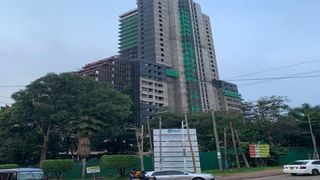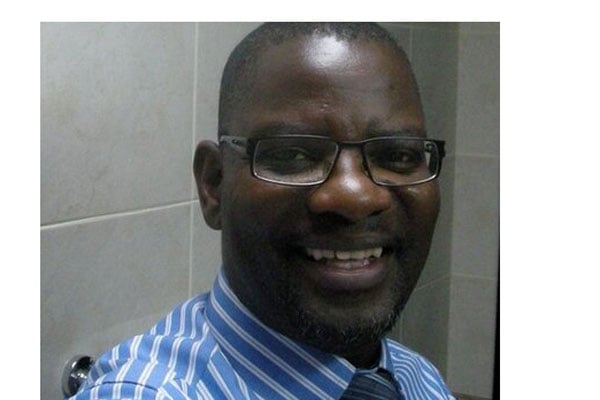
The Pension Towers, the office complex NSSF is constructing in Nakasero, a Kampala suburb. PHOTO/ FILE
|Special Reports
Prime
Cracking the myths in Pension Towers
What you need to know:
- Is the NSSF management covering up a crack in the Pension Towers? Resident engineers and external experts say no, but varying interests mean the matter refuses to go away as the third instalment of our series details.
Apart from the various forces that were pushing the National Social Security Fund (NSSF) to acquire Madhvani’s Nakigalala land despite ongoing ownership disputes over it, other fights were ongoing.
Towering among them was the fight over the Pension Towers, the office complex NSSF is constructing in Nakasero, a Kampala suburb.
NSSF is today’s meal. Byarugaba is the first course
Conceived in 2006, construction of the towers started in 2008 while Mr David Chandi Jamwa was still at the helm of the firm. Fifteen years later, the tower remains incomplete, but it has had more audits and investigations than its 25 floors.
Right from inception, it has also had more allegations of corruption than perhaps any other public project in Uganda.
Unfortunately for NSSF and its members, this appears to be the rule, rather than the exception.

Construction of Worker’s House, NSSF’s head office on Pilkington Road in Kampala, which started in 1994 and was completed in 2001, was similarly mired in endless allegations of corruption and expensive litigation.
Apart from coming in beyond budget and past deadline, it contributed to Abel Katembwe, the then NSSF managing director (MD), losing his job.
Pension Towers also contributed to the departure of former MD Jamwa and now threatens to bring down another top boss at the Fund.
Thankfully, it is one of the easier problems to investigate at the Fund.
In her now-famous letter declining to reappoint Mr Byarugaba, Labour minister Betty Amongi made specific allegations that five percent of the contract sum of $110 million (Shs403b) was paid to the NSSF MD as a commission.
“The money was wired to a bank in Mauritius and then to Barclays Bank in London, according to a source who is willing to provide information directly to H.E [President] and provide evidence of transaction,” the minister wrote.
Ombudsman’s focal point
With such specific details, the on-going investigation by the Inspector General of Government (IGG) should easily confirm or disprove these claims.
The minister also faults the way the contractor was selected, and says the contract was varied in a way that materially leaves the Fund at a financial disadvantage.
She says the original contract required the contractor to use their own money to build, with NSSF paying equivalent money into an interest-bearing escrow account that would be accessed on successful completion.
Instead, she says NSSF changed the terms of engagement and started paying the contractor directly against certificates of completed phases of the work, forfeiting the interest that would have gone to members.
“Now that they have been paid earlier than the period that was anticipated at bidding, has the interest reduced? Did the MD disclose this and where is the money for interest?” Ms Amongi asked in her letter.
In a statement, NSSF declined to comment on specific matters under investigation.
An official at the Fund said the pre-financing model included interest that the contractor would charge on their money.
“At the very best, there would have been no gain since the interest earned on the money would be paid back to the contractor in the form of interest on their money invested in pre-financing.
It is also possible that the interest from the pre-financing would be higher than the interest from the escrow account and cost the Fund more money as a result.” The official spoke on condition of anonymity because they are not authorised to speak on behalf of the Fund.
A simple audit should be able to establish whether any changes in the way the contractor was paid left NSSF and its members with more money, or less.
The IGG’s investigation should also provide insights into the decision-making and whether there was approval from the Board and the Solicitor General in any amendments to the contract.
A crack in the tower
A separate claim contained in one of the whistle-blower dossiers that emerged towards the end of Mr Byarugaba’s contract alleges that there is a crack in the Pension Towers that emerged from a structural defect in the building.
This claim is not contained in the minister’s letter and is not understood to be one of the issues the IGG is looking into.
The claim is not new and, given the start-stop nature of the works, perhaps not entirely unexpected.
Before works began on phase two of the project, a structural integrity appraisal done at NSSF’s request found some curable defects and recommended remedial work, which is understood to have been done.
Before construction of the main concrete frame, another independent quality assessment was undertaken, in September 2021, to test the quality of the reinforced concrete works. This newspaper has seen a copy of the resulting report by the technical experts.

Labour minister Betty Amongi
“From the summarised results above, it can be concluded that the structure was found in fairly good condition,” the report notes. “Good in the sense that some of the elements were meeting target surface strength and had no deformation or deterioration. Fair in the sense that some elements did not meet the targeted strength and observation of honeycombs in one of the beams.”
The report also noted: “This was a small area and honeycombs are not a serious issue over small areas. As we did not access the entire structure, honeycombing may be present and if it covers a large area and depth in concrete, it becomes a major issue.”
DON'T MISS:
‘It’s not a structural crack’
Despite no clear evidence of a “crack” in the building, the matter refused to go away. In November 2022, Mr John Senfuma of Seka Associates Consulting Engineers, the civil and structural engineer on the towers, was invited to yet another meeting of the board to discuss the “crack” issue.
In a written submission to the board, he detailed previous inspections and findings and reiterated that there was no structural distress on the building and no need for yet another structural integrity audit on the building.
“If there is any crack in the building that has developed or will develop in future, it is not a structural crack. It will be carefully evaluated and will be successfully repaired and never to appear again,” Mr Senfuma wrote. “The engineer takes full responsibility [for] all the approved structural works on the site.”
Those pushing for a new structural integrity audit say the Fund should not trust the word of the engineers working on the project.
The engineers say their own assessments and those of independent parties show that any defects are minor and to be expected in a project of this magnitude.
Officials at NSSF worry that the technical arguments are likely to be lost in the political and power fight over control of the Fund.

Richard Byarugaba
Symptom of bigger malaise
This newspaper understands that a separate technical review of the different reports on the project is underway, with the knowledge of the President, and should help settle the argument.
Yet the fight over what should be a simple matter for technical interpretation is symptomatic of a lot of what happens around NSSF given the many interests around it.
In her letter, for instance, Minister Amongi notes—with justification—the slow uptake of the NSSF houses in Lubowa and Temangalo.
The minister wonders why the houses are not sold off-plan, before construction, so that they are more affordable and more of them are sold off by the time of completion.
NSSF officials asked about the matter say they would prefer this method, but their hands are tied by public procurement rules.
“Our core mandate is not property development and the rules say that we sell a finished product by taking the cost and adding a mark-up to it,” an official said. Like others at the Fund, they asked to speak off the record because they are not authorised to speak for the Fund.
“If we offered a house at [an] off-plan price, we wouldn’t know what the final price of the house would be, given that costs tend to vary in big projects. If, at completion, the houses then cost more than we sold them for, we would be accused of selling at a loss and losing members’ money.”
Some of these are logical issues easily explained away in most companies. However, as we shall see in the next article, the over-arching interests in NSSF, which range from management, the board, the ministers and other informal power centres, means that even the smallest issues can be blown out of proportion while it is almost impossible to carry out major projects without influence-peddling.
With reporting by Jane Nafula.




